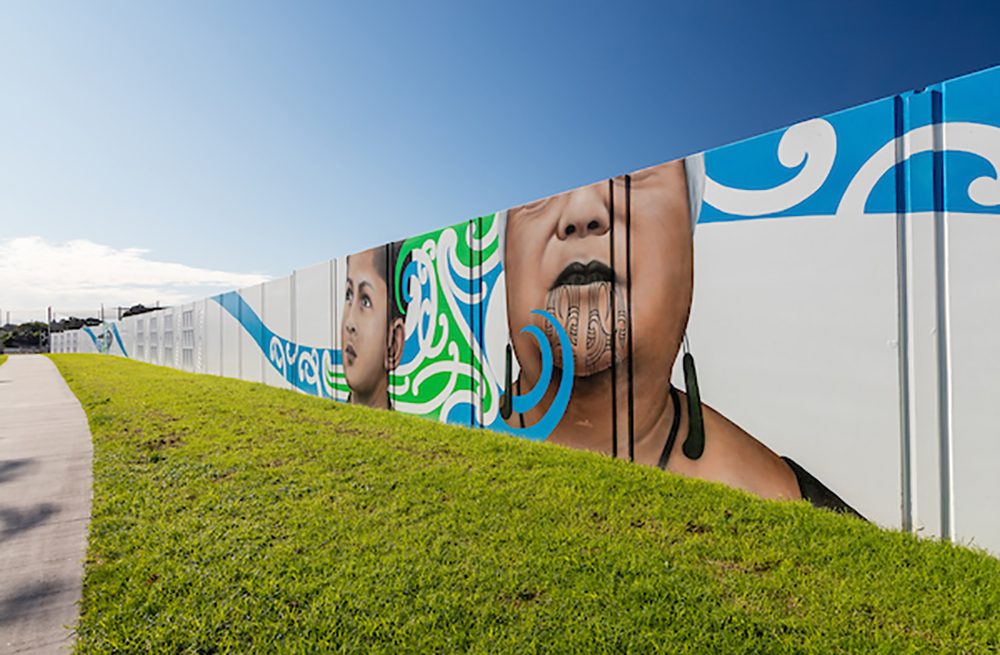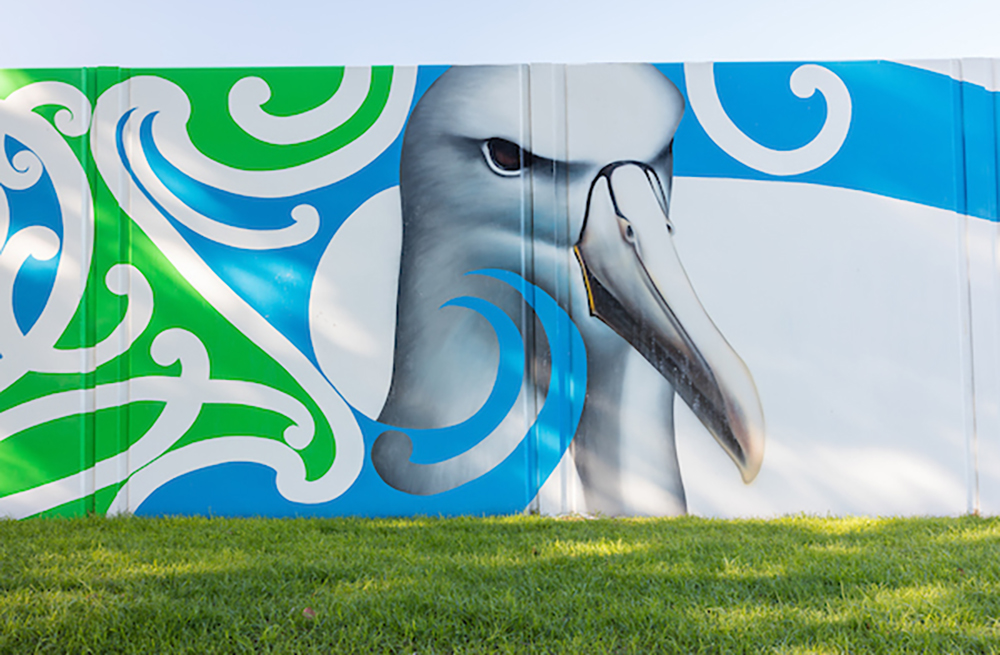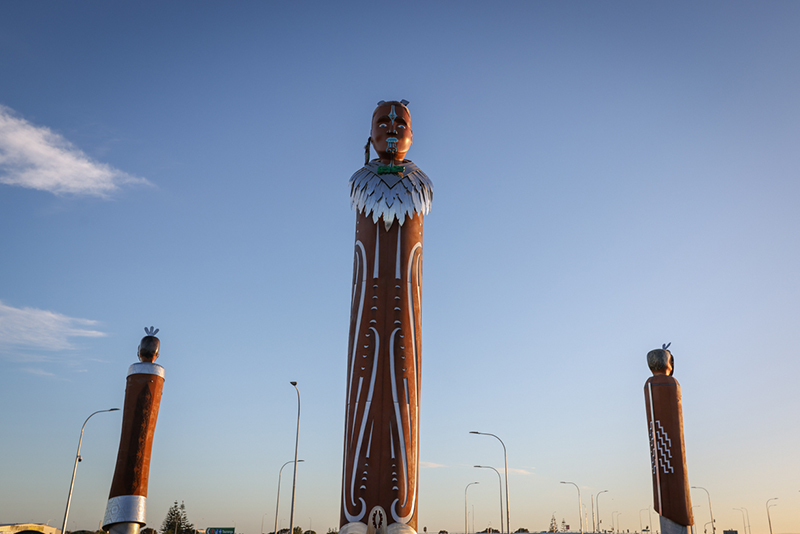
Artists: A collaboration of Ngāi Tūkairangi and Ngāti Tapu, designed by local artist Stu McDonald alongside Owen Dippie and their team.
The concrete wall behind HomeZone, near Russley Drive in Matapihi, was installed as part of the Bay Link project to reduce the noise to nearby residential properties from the relocated railway line. It has also provided a canvas for local hapū to tell their unique story. The vibrant mural represents the significant historic places, people and resources of the hapū from Matapihi.
He ara tēnei nō ō mātou tūpuna i ngā wā o te riri kia whakangungu i tō rātou whenua. He wāhi okiokinga hoki kia horoi ō rātou pia.This is the pathway where our ancestors travelled in times of war in defence of the land. And also a resting place for the washing of their weapons.
The rail noise wall artworks are symbolic depictions of life’s journey and the path travelled by Matapihi hapū (tribal groups) through history. The circular awhiowhio patterns symbolise whānau (family), whanaunga (relatives) and people who surround and help us, with ourselves in the centre. The triangular niho taniwha patterns symbolise challenges and dangers faced along life’s path. Just as whānau outnumber the challenges faced, the design has more circular patterns than triangles.
The painted panels represent the three life principles of tāngata whenua: Mana Whenua (Harmonious integration with the environment), Mana Tangata (Realisation of human potential) and Mana Motuhake (Self-determination through your absolute uniqueness). The blue and green kōwhaiwhai represent the many springs and waterways that were once located throughout Matapihi.
Mana Whenua (Harmonious integration with the environment)

The painted mountain range is an artistic representation of the view across the harbour towards an ancient pā site in Matapihi named Te Mānia. It was one of the earliest and largest settlements in Tauranga at the time. The hautere (mackerel fish) was a local food source of the area. Being a schooling fish was key to their survival which can be likened to local leaders who were skilled in practicing kotahitanga (collaboration) in times of need.
Tāngata whenua lived by the customary practices of gathering from the whenua (land) and moana (sea). The hautere and the large shellfish beds of pipi, tuangi, kukuroroa and tītiko attracted a bounty of other seafood resources into Te Awanui (harbour entrance channel) such as tāmure (snapper), haku (kingfish), kahawai, and kuparu (John Dory).
The estuarine areas were plentiful with kaimoana such as pātiki (flounder), kanae (mullet), parore (breamfish) and pāpaka (crabs). Before the many bridges and causeways were built, the harbour and estuaries were often visited by aihe (dolphins), tohorā (whales) and maki (orca), and their presence are often viewed as kaitiaki (guardians) along with the whai (stingray) and the mangō (shark).
There are many historic kāinga areas (homes) throughout this area which were strategically placed for access to freshwater, resources and fertile lands for gardens. Maintaining the mana of our environment is expressed through kaitiakitanga (guardianship of our lands and waters). The health and wellbeing of our people is inextricably intertwined with the health and wellbeing of our environment.
Mana Motuhake (Self-determination through your absolute uniqueness)

The taiaha symbolises the name of an ancient waterway of this area named Horoipia, which means ‘to wash spears’. There were many puna-wai (freshwater springs) throughout this area; specific areas for the toa (warriors) to purify and cleanse their taiaha after battle. The toroa (albatross) symbolises the ancient kaitiaki that helped to guide Mātaatua waka to Aotearoa. Toroa was the name of the captain of Mātaatua waka. The downy feathers of the toroa are represented in the naming of Hungahungatoroa marae in Matapihi.
Tauranga Moana lands were sought after by both other tribes, and the Crown for the bountiful harbour, fertile lands, and strategic location. Rawiri Puhirake and other leaders built a number of strategic pā which he invited the Crown to attack as he knew his people were outnumbered and outgunned. By choosing the battleground, he gained the upperhand.
The introduction of musket guns to Aotearoa led Māori to develop innovative defensive pā and trench systems such as those engineered by Penetaka Tuaia at the Battle of Gate Pā, Pukehinahina. He was viewed by historians as an ‘innovative master of field fortification’. It is said that the British did not win the New Zealand Wars through superior technology, superior methods or any kind of superiority at all. They won because of their overwhelming numbers.
Mana Tangata (Realisation of human potential)

To uphold the mana of one of the tupuna wahine (female ancestor), Te Aho o Te Rangi, the wife of Koraurau, is acknowledged. In 1828 when Otamataha was sacked by Ngāti Maru, hundreds of Tauranga Māori were killed. The Chief Koraurau was killed in this battle. Survivors of this attack swam across the harbour to the kāinga at Whareroa where Ngāi Tūkairangi and Ngāti Kuku were based at the time. One of those that made this journey across the harbour was Te Aho o Te Rangi. She swam across from Otamataha to Whareroa with her baby on her back. The baby was Hohepa Hikutaia. As she was swimming across the harbour she was picked out in the light of the fires and shot. However, she managed to survive long enough to reach the shores of Whareroa, delivering her child to safety. The moko kauae or traditional female chin tattoo is depicted to honour this local ancestress. Her bravery ensured that a bloodline was saved.
Te Ariki is a local Matapihi boy whose ancestry and genealogy are entrenched in the land and surrounding waterways. His depiction speaks to the importance of tamariki (children) and the role they play in the future.